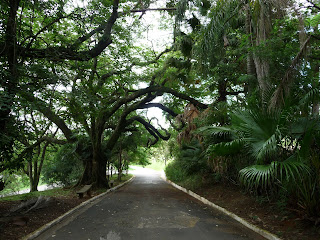
Today Jocelyn, her son Sean, David, Hope and I went to the Emílio José Salim Ecological Park in Campinas. Originally it was an 18th century plantation built in a region inhabited predominantly by French colonials. The primary crops were sugarcane, cotton, and corn. Later, in the 19th century, coffee would become its primary cash crop. Although initially the fields were worked by the indigenous people of the region, they were soon replaced by slaves. I am still trying to wrap my head around the issue of slavery, which is huge, but will post more about it soon.


 The other thing that was really cool about this park was that it was free. There was no entrance fee to get in, nor was there a charge to go into the casarao museum. There were, however, many guards who watched us quite carefully as we toured around the park.
The other thing that was really cool about this park was that it was free. There was no entrance fee to get in, nor was there a charge to go into the casarao museum. There were, however, many guards who watched us quite carefully as we toured around the park.
The person most closely associated with the original plantation is Luzia Maria de Sousa who, in 1817, married her cousin and, in 1820, inherited the plantation from her father. Luzia Maria and her husband were considered among the rural aristocracy of the region, which included lots of titles such as viscountess and baroness and even a visit from the emperor of Brasil, Dom Pedro II. Luzia and her husband were also quite entrepreneurial in spirit as they are thought to be the first planters in Sao Paulo state to grow and export coffee.

Today the plantation is an ecological park containing the casarao (marriage house), a granary and a small ingreja (church) along with lots of walking trails, a lagoon and other outbuildings. 


 The other thing that was really cool about this park was that it was free. There was no entrance fee to get in, nor was there a charge to go into the casarao museum. There were, however, many guards who watched us quite carefully as we toured around the park.
The other thing that was really cool about this park was that it was free. There was no entrance fee to get in, nor was there a charge to go into the casarao museum. There were, however, many guards who watched us quite carefully as we toured around the park.

No comments:
Post a Comment